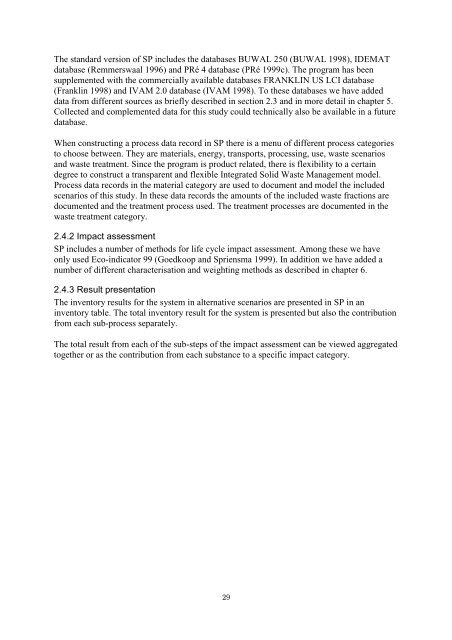Life Cycle Assessments of Energy From Solid Waste (PDF)
Life Cycle Assessments of Energy From Solid Waste (PDF)
Life Cycle Assessments of Energy From Solid Waste (PDF)
You also want an ePaper? Increase the reach of your titles
YUMPU automatically turns print PDFs into web optimized ePapers that Google loves.
The standard version <strong>of</strong> SP includes the databases BUWAL 250 (BUWAL 1998), IDEMAT<br />
database (Remmerswaal 1996) and PRé 4 database (PRé 1999c). The program has been<br />
supplemented with the commercially available databases FRANKLIN US LCI database<br />
(Franklin 1998) and IVAM 2.0 database (IVAM 1998). To these databases we have added<br />
data from different sources as briefly described in section 2.3 and in more detail in chapter 5.<br />
Collected and complemented data for this study could technically also be available in a future<br />
database.<br />
When constructing a process data record in SP there is a menu <strong>of</strong> different process categories<br />
to choose between. They are materials, energy, transports, processing, use, waste scenarios<br />
and waste treatment. Since the program is product related, there is flexibility to a certain<br />
degree to construct a transparent and flexible Integrated <strong>Solid</strong> <strong>Waste</strong> Management model.<br />
Process data records in the material category are used to document and model the included<br />
scenarios <strong>of</strong> this study. In these data records the amounts <strong>of</strong> the included waste fractions are<br />
documented and the treatment process used. The treatment processes are documented in the<br />
waste treatment category.<br />
2.4.2 Impact assessment<br />
SP includes a number <strong>of</strong> methods for life cycle impact assessment. Among these we have<br />
only used Eco-indicator 99 (Goedkoop and Spriensma 1999). In addition we have added a<br />
number <strong>of</strong> different characterisation and weighting methods as described in chapter 6.<br />
2.4.3 Result presentation<br />
The inventory results for the system in alternative scenarios are presented in SP in an<br />
inventory table. The total inventory result for the system is presented but also the contribution<br />
from each sub-process separately.<br />
The total result from each <strong>of</strong> the sub-steps <strong>of</strong> the impact assessment can be viewed aggregated<br />
together or as the contribution from each substance to a specific impact category.<br />
29
















